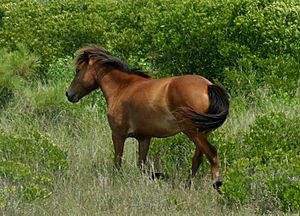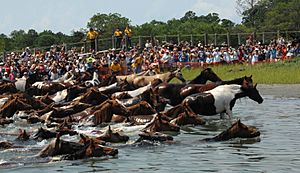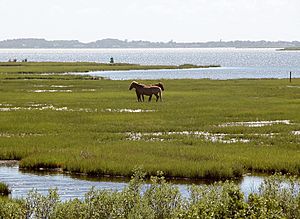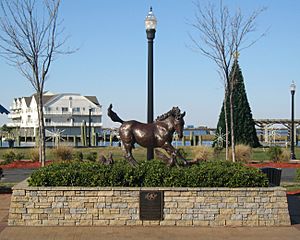Chincoteague Pony facts for kids
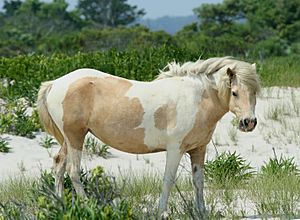
Chincoteague pony
|
|
| Distinguishing features |
|
|---|---|
| Alternative names | Assateague horse |
| Country of origin | United States |
| Breed standards | |
| National Chincoteague Pony Association | Breed standards |
| Horse (Equus ferus caballus) | |
The Chincoteague pony is a special kind of horse. It lives wild on Assateague Island in Virginia and Maryland, USA. These ponies became famous from the Misty of Chincoteague books. Marguerite Henry wrote them starting in 1947. Even though they look like horses, they are called "ponies". This is because they are smaller. Their small size is partly due to the tough living conditions on Assateague Island.
Chincoteague ponies come in many colors. You can find them in any solid color. They are often seen with pinto patterns, which means they have patches of white and another color. These patterns are very popular with people who love the breed. The ponies on the island eat plants and brush from the salt marsh. This food is often scarce and not very nutritious. In the past, this led to some health issues. But now, new bloodlines have been added to make them stronger.
There are many stories about how the Chincoteague ponies first arrived. The most popular story says they came from a Spanish ship that sank. It's more likely they came from horses left by colonists in the 1600s. These colonists wanted to avoid taxes and laws on the mainland. In 1835, the tradition of pony penning began. Local people would round up the ponies. Some were taken to the mainland. In 1924, the Chincoteague Volunteer Fire Company held the first official "Pony Penning Day." They auctioned ponies to raise money for fire equipment. This yearly event still happens today.
The wild ponies live on Assateague Island. The island is owned by the government. A fence splits it at the Maryland/Virginia state line. About 150 ponies live on the Virginia side. Around 80 live on the Maryland side. Different groups manage these herds. The Maryland ponies are called Assateague horses. They are treated like wild animals. The Virginia ponies are called Chincoteague ponies. The Chincoteague Volunteer Fire Company owns them. These ponies get vet check-ups twice a year. This helps them if they are sold to new homes. While about 300 ponies live on the island, around 1,000 more live elsewhere. They are owned by private breeders.
Contents
What Makes Chincoteague Ponies Special?
Chincoteague ponies are often called ponies, but they look like horses. Wild ponies are usually about 13.2 hands (54 inches, 137 cm) hands tall. But when they are cared for, they can grow to at least 14.2 hands (58 inches, 147 cm) hands. They usually weigh around 850 pounds (390 kg). You can find them in all solid colors. They also come in pinto patterns. Pinto ponies often sell for the most money at the yearly auction.
Because new bloodlines were added, their looks can vary. Generally, they have a straight or slightly curved face. They have a wide forehead and a refined neck. Their shoulders are well-angled. They have a broad chest and a short, strong back. Their legs are usually straight and sturdy.
Domesticated Chincoteagues are smart and eager to please. They are easy to train. People use them for hunting, driving, and trail riding. They are also very hardy and can live on little food. In the late 1800s, one writer praised their good manners. He told a story of a pony that carried a man and his gear for 1,000 miles (1,600 km) in 34 days. The pony weighed about 500 pounds (230 kg).
Where Do Chincoteague Ponies Come From?
Many legends explain the ponies' origins. One popular story says they came from Spanish horses shipwrecked off Virginia. Another says pirates left them on the island. These stories are probably not true. There is no proof of horses on the island that early.
It's more likely that farmers brought their horses to the islands in the 1600s. They did this to avoid taxes and fencing laws on the mainland. Many animals, like hogs, sheep, cattle, and horses, were brought there. The National Park Service believes this theory. However, the Chincoteague Volunteer Fire Company, who owns the Virginia ponies, believes the Spanish shipwreck story. They say horses were too valuable to be left wild in the 1600s. They also point to two sunken Spanish ships off the coast. The National Chincoteague Pony Association also supports the shipwreck theory.
In the early 1900s, the ponies were described as small but strong. They were said to have been on the islands since before the American Revolution.
Improving the Breed
In the 1920s, many ponies had health problems. This was due to uncontrolled inbreeding. They had misshapen legs and narrow chests. Many ponies were stunted and did not grow tall. This was partly because of the limited food on the islands. Only the strongest ponies survived in this harsh environment.
To improve the herd, new blood was added. Welsh and Shetland ponies were brought in. Horses with pinto coloring were also introduced. This gave the herd its unique patterns. It also made them look more like horses. In 1939, twenty Mustangs from the Bureau of Land Management were added. Arabian horses were also used to make the ponies taller and more refined. One Arabian stallion was released with the herd but did not survive. Another was bred to mares taken off the island.
The Chincoteague pony's history is similar to the Shackleford Banker Horse. These horses live off the coast of North Carolina. However, the Shackleford horses are more isolated. No outside blood has been added to their herd.
The Famous Pony Penning Event
The first written mention of "pony penning" was in 1835. But people had been rounding up animals on the island for many years before that. At first, it was to mark animals for ownership. By 1885, it became a festival. Two days of horse and sheep roundups were held. Over time, the sheep population decreased, but the ponies grew. In 1909, the last Wednesday and Thursday of July became the official days for pony penning.
In the early 1920s, a wealthy farmer bought much of Assateague Island. Many settlers moved to Chincoteague Island. This changed the pony penning event. By 1923, most of the event moved to Chincoteague Island. The ponies were first moved by truck. Then, the annual swim began. In 1922, a causeway connected Chincoteague Island to the mainland. After two fires on the island that year, the Chincoteague Volunteer Fire Company was formed. In 1924, the first official Pony Penning Day was held. Foals were auctioned for $25–50 each. This money helped buy fire equipment. Pony Penning Day has been held every year since, except for 1942, 1943, and 2020.
Today, up to 50,000 visitors come on the last Wednesday in July. They watch riders bring the Virginia herd from Assateague. The ponies swim across the channel to Chincoteague Island. The swim takes about five to ten minutes. Riders and observers help the ponies, especially the young foals. Before the swim, pregnant mares and those with very young foals are removed. They are taken by trailer between the islands. During the swim, some nursing mares can get sick. Vets are on site to treat them.
The larger foals are auctioned the next day. Most of the herd, including young foals, return to Assateague on Friday. In 2015, the highest price for a pony was $25,000. The lowest was $500. Some ponies are "bought back." This means the bidder donates money to the fire department. Then, the pony is released back onto Assateague Island.
Keeping Track of the Ponies
The National Chincoteague Pony Association was started in 1985. The Chincoteague Pony Association began in 1994. The second one is only for ponies bought at the auction. The first one keeps a breed registry and studbook. It registers all ponies, even those from private breeders. Many ponies are registered with both groups. There are almost 1,000 Chincoteague ponies owned by people off the island. They live across the US and Canada.
How the Ponies are Managed
Assateague Island is split between Maryland and Virginia. Two separate herds of ponies live there. A fence separates them at the state border. The Maryland ponies are called "Assateague horses." The National Park Service manages them. The Virginia ponies are called "Chincoteague ponies." The Chincoteague Volunteer Fire Department owns them.
In 1943, the government bought the whole island. It was divided into two protected areas. These are Assateague Island National Seashore in Maryland and Chincoteague National Wildlife Refuge in Virginia. Different government groups manage the two herds. They use different strategies. The Maryland side also has Assateague State Park. Ponies can roam there, but the state does not manage them much.
The wild ponies live in small groups. Most groups have a stallion, several mares, and their foals. The ponies on Assateague mostly eat cordgrass. This coarse grass grows in salt marshes. It makes up about 80 percent of their food. They also eat other plants like rose hips and bayberry. Chincoteague ponies need twice as much water as other horses. This is because their diet is salty. Drinking more water can make some ponies look bloated.
Maryland Herd Management
The Maryland herd is managed by the National Park Service. This herd is great for scientific study. Since the late 1970s, scientists have studied their behavior. They look at how the ponies live in groups. They also study how humans affect wild animals. Few other wild animals have been studied in such detail for so long.
The herd grew from 28 ponies to over 165 between 1968 and 1997. Too many ponies caused overgrazing, which harmed their environment.
The Maryland herd might carry equine infectious anemia (EIA). To prevent it from spreading, no riding or camping with private horses is allowed. This is during the insect season, from May to October. These ponies are wild animals. They can be aggressive. There have been reports of them biting or kicking visitors. In 2010, the National Park Service started new ways to teach visitors about the ponies. They added safety info to brochures. They also suggested safe viewing distances. Visitors can also harm the ponies. Ponies have gotten sick from eating human food. On average, one Maryland pony a year is killed by a car. Since 1991, "Pony Patrol" volunteers on bikes teach visitors about the ponies.
Virginia Herd Management
The Virginia herd is owned and managed by the Chincoteague Volunteer Fire Company. The US Fish and Wildlife Service (FWS) allows the ponies to live on Assateague. They have a special permit for grazing. About 150 adult ponies live in the Chincoteague National Wildlife Refuge.
About 60 to 70 foals are born into the Virginia herd each year. The annual Pony Penning helps keep the herd size around 150 animals. Since 1943, the FWS has worked to protect wildfowl on the island. Their efforts have sometimes affected the ponies. The FWS has put up fences. This means less land for the ponies to graze. The fences also stop them from reaching the sea. They used to go there to escape biting insects like mosquitos. In 1962, some ponies died in a storm. They were trapped by high water and carried out to sea. Unlike the Maryland herd, Virginia ponies are fenced off from roads. This prevents car accidents and stops visitors from feeding them.
In the late 1900s, some ponies sold at auction were returned to the island. This happened when the population dropped too low due to storms or other issues. Since 1990, the Virginia ponies are rounded up twice a year for vet care. They get deworming and vaccinations for diseases like rabies and tetanus. They also get shots for Eastern and Western encephalitis. But they only swim to Chincoteague once a year. A fire department committee also monitors them. They give basic first aid for minor injuries. This care is important because many ponies will be sold to private buyers. During vet visits, they are also tested for EIA.
The Story of Misty of Chincoteague
In 1947, Marguerite Henry wrote Misty of Chincoteague. This children's book was the first in a series. It made the Chincoteague breed famous around the world. The real Misty was born on Chincoteague Island in 1946. Henry bought her as a young foal. In 1961, the movie Misty was made, based on the book. This brought even more attention to the ponies. The fame from the books helped the Chincoteague Fire Department and the breed survive.
Even though the books were fictional, they were based on a real horse and ranch. The Misty of Chincoteague Foundation was started in 1990. Its goal was to save the Beebe Ranch. It also wanted to create a museum with items from the book series. The model horse company Breyer Animal Creations has made models of Misty and her descendants. As of 2001, about 40 of Misty's descendants were still alive worldwide.
Images for kids


